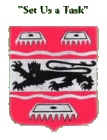
1st Lt. WESLEY ROSS
3rd Plt. Co. "B"
146th Engineers Combat Battalion
We were kept busy for the first few months after entering Germany — building bridges, repairing roads, laying anti-personnel mines (AP) and anti-tank (AT) mines; and using explosives to destroy the Siegfried forts, which were then bulldozed full of dirt to render them useless, if they were recaptured. These pillboxes were laid out to be mutually supportive — in attacking one, the attacker came under fire from one or more adjacent pillboxes.
The third platoon was charged with destroying a twenty-pillbox strongpoint in Höfen — a mile southeast of Monschau and near the front. We had no inkling as to the amount of explosives required to destroy these behemoths whose reinforced concrete walls and ceilings were more than six feet thick, and had steel domes and embedded steel embrasure plates 8" to 12" thick. They were built by Todt construction crews in the late thirties under the direction of Hermann Goering, who was then in charge of the Third Reich armaments, Our field manuals gave us no clue on how to destroy these monsters, and our past training had not addressed anything even close to that size — so we winged it.
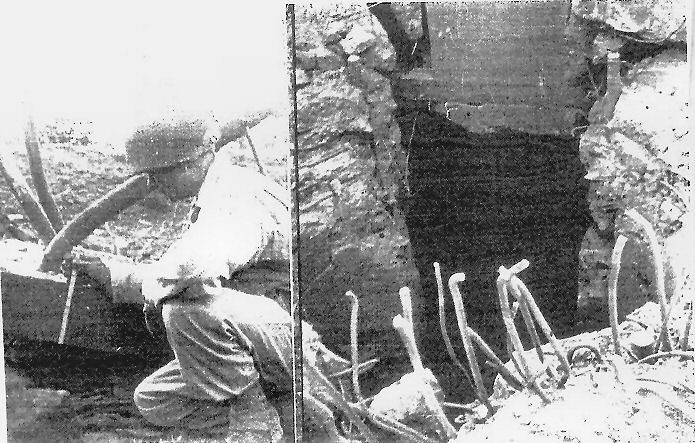
One of the demolished pillboxes at Höfen
On our initial attempt, we placed a 50 pound case of TNT below a big steel dome, and touched it off. From my past experience, fifty pounds of TNT seemed to be a healthy starting point, even though I thought it might possibly be excessive. There was a muffled "poof" and black smoke wafted out from the firing embrasures, but no structural damage resulted. Had this pillbox been recaptured, its effectiveness would have essentially been unimpaired.
To save on TNT, someone up the chain of command suggested that we try explode a pile of captured large-caliber German artillery shells inside a pillbox. As expected, this proved to be even less effective, as the total amount of explosive in the shells was pitifully inadequate for the job. Only a few of the shells detonated, and the remainder were scattered around and would then be very dangerous to handle — we moved them very gingerly!
Out of the blue, we were suddenly blessed with a windfall of captured German granular TNT in 100kg cardboard barrels. By trial and error we settled on a charge of six barrels for the large pillboxes. 1 kilogram is 2.2 pounds, so these pillboxes were being charged with up to two thirds ton of TNT. After the first few trials, the TNT was stacked back a few feet from the exterior walls so as to not blow a hole through the wall without splaying out the rest of the structure. Occasionally we overdid it — as was the case where an eight-inch-thick slab of reinforced concrete had been laid over a ceiling hole where a future steel dome had apparently been planned.
Dirt and grass covering the slab concealed it's structural weakness. That 8' x 12' "concrete blanket" flew no less than 200 feet straight up in the air, and from several hundred yards away we could hear it going sswwisssh, sswwisssh, sswwisssh, as it flopped over and over on its trip back to earth. This raised a cloud of dust, and the German artillery then heavily shelled the nearby area — which did little to endear us to those men from the 9th Infantry Division.
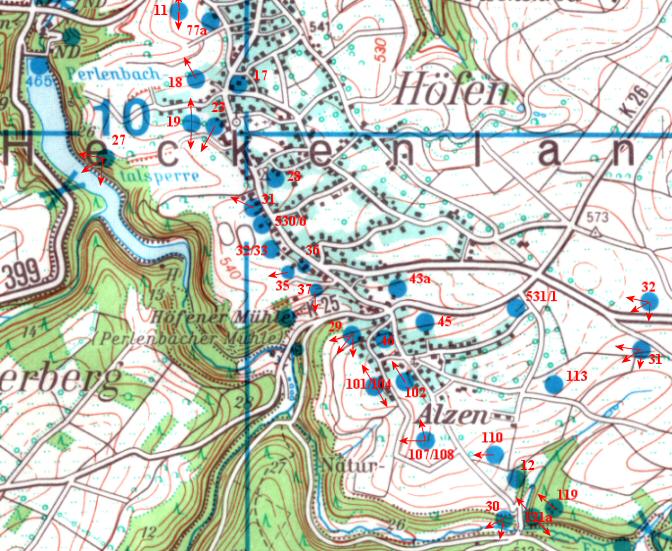
Two of the pillboxes in the Höfen strongpoint had eleven inch thick steel domes seven feet high and seven feet in diameter, with embrasures (slits for small arms) near the top, through which rifles or machine guns could be fired. Only the top of the domes projected above ground and they were anchored by nine 2 1/2+" diameter steel bolts embedded 27" into the reinforced concrete base. Our TNT charge poofed one of these multi-ton corks WAAAY UP, and it gave out a resounding "clank" as it buried itself four feet into the hard ground on its return trip to earth. This also was undoubtedly a slight TNT overload!

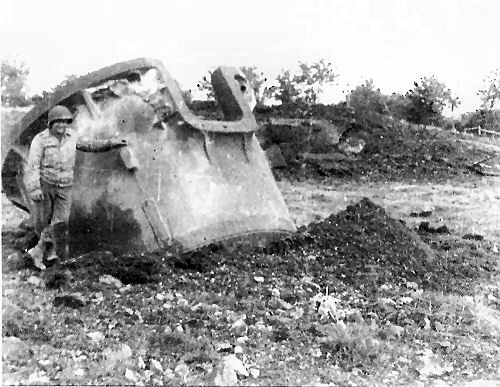
Jeep driver Chester King leaning on 7'-11" thick steel dome after its low orbit back to earth.
We destroyed an unusual pillbox northeast of Höfen's town center. After being built, a stone barn had been constructed around it to conceal its function. This allowed for an effective field of fire of its machine guns from the two east-firing embrasures — and must have been located to fire east in case this area were overrun or bypassed. It was completely disguised until the two barn doors were thrown open, exposing the firing embrasures. In the living area, a dirty greasy rag turned out to be a hand-woven and crocheted bedspread. After several dry cleanings, it was almost as good as new, and was used as a table covering for our wedding in January 1946. It is now used as a guest room bedspread.
We loaded up that pillbox with our large charge and touched it off without realizing that pigs were in the surrounding brush. A lovely explosion resulted, with stones flying all over, but the thick concrete roof flipped over on top of the pigs, trapping them beneath. Several of them squealed for two days despite our efforts to locate them and put them out of their misery. Our after Action Report stated "Company B destroyed 32 pillboxes and observation posts (*) in the vicinity of Höfen during the month" * Not all were destroyed by the 3rd Platoon — WR

The location of pillbox 107/108 at Alzen.
In many cases what remains of the pillboxes is covered with dirt.
Thor Ronningen, from I-Company, 395th Infantry Regiment, 99th Infantry Division sent the following in a 1995 letter about Engineers, Pillboxes, and Explosives at Höfen:
"One day our lieutenant decided that we should dig a hole about 25 yards north of Gasthaus Schmiddem. About the time we got it completed, we were fired on by a burp gun, and four or five of us dove into the two-man hole. We radioed that we were going to come back to our lines, but were told that we would have to wait as "THE ENGINEERS" were going to blow a barn about 100 yards west of us. Just then the barn blew up and pieces of concrete(*), some as large as basketballs, rained down all around us. Fortunately, no one was injured. This must have been your people" — 3rd Platoon, B-Co, 146ECB — * THE "PIECES OF CONCRETE" UNDOUBTEDLY WERE THE EXTERIOR STONES FROM THE BARN THAT CAMOUFLAGED THE PILLBOX BENEATH.—WR

Höfen pillbox in stone barn.
As a further tidbit, Thor stayed in the Gasthaus Schmiddem from November 1944 through January 1945. I had sent him a photo of the town, taken in 1994, that had inadvertently included the Gasthaus Schmiddem. Thor(*) said "It looks a whole lot better now than when we left it — all of the glass was gone, the back roof was caved in, bullet and shrapnel holes were all over and there were mortar holes in the front roof." * THOR IS THE AUTHOR OF "BUTLER'S BATTLIN' BLUE BASTARDS"— THE HISTORY OF THE 3RD BN, 395 INF, 99th DIV, WHICH HELD THEIR POSITION AND FOUGHT SO EFFECTIVELY AT Höfen DURING THE BULGE — UNDER THE COMMAND OF LT COLONEL McCLERNAND BUTLER.)
Early one morning, the new infantry outfit requested that we destroy two additional pillboxes within this Siegfried strongpoint. There was only one small problem — both were still in German hands! I'm not sure how we were conned into this infantry mission, but the request came down through channels. As a matter of record we failed, and these pillboxes were not captured until February 1945 — after the Bulge had run its course.
Our initial request was to destroy the pillbox shown on their map-overlay as being about 200 yards forward of our front line, near the crest of the forested slope leading down to Monschau, a mile northwest. Either it was shown in error — or may have been so well camouflaged that we failed to locate it. A dismounted contingent from the 38th Cavalry Squadron provided our cover. We carried 400 pounds of granular TNT in eight gunny sacks, to be stacked in the pillbox embrasure. This would have blown the steel embrasure back into their laps, and would have ruined an otherwise uneventful day.
While attempting to locate the pillbox, we moved east in no-mans-land near the edge of the canyon, with open fields to our right (south), and a heavily wooded downward slope on out left (north). I suddenly realized that although the cavalry had put out a point man, they had provided no left flank protection — so I immediately sent out two of my men.
They had gone no more than 50 feet when they bumped into two Germans coining up the hillside trail, looking for us. From thirty feet away, Albert Tucker fired a clip from his M-l so fast that it sounded like a burp gun, but it is doubtful that he hit either of them. However, hie rapid-fire technique must have impressed the Germans, and they disappeared down the trail — while their hidden compatriots fired away at us with evil intent.
I dove head-first behind a small rockpile, thereby splitting the forearm on the M-1 carbine stock, so that it pinched my hand with every round fired. From that day forward I carried an M-1 Garand or a Thompson sub, even though the carbine undoubtedly was a better platoon leader's weapon. We fired away at phantoms for a short interval, but being at a disadvantage in numbers, and without adequate cover, we pulled up stakes and "attacked to the rear". Luckily for us, these Germans were not superb marksmen, and none of us were wounded.
Since we had never located the first pillbox, the infantry suggested that we forget about it, and blow the pillbox whose location we all knew. It was 125 yards above the narrow road that we traveled when jeeping in and out of Höfen. Sited on a western-facing slope, with a seventy degree field of fire, it overlooked the short section of our entry road not in defilade. On every trip to and from Höfen, we could have been observed from the firing embrasure. For the fifty feet of the road where we were visible, we ducked and gunned the jeep on through.
For this demolition job, we had more time to prepare. I requested that the infantry give us a five minute mortar barrage to the rear of the pillbox every half-hour for the nest five hours. When the enemy had become used to this periodic firing schedule — which they may have accepted as normal — three of us planned to approach the pillbox from the rear, immediately after the last mortar rounds bad landed.
We would then neutralize the defenders momentarily and wave in the eight men with the sacks of TNT that had been "saved" that morning. Initially all went well. While the final mortar barrage was still in progress, two of my men (names long since forgotten) slipped down the right side of a slender finger of woods that projected within 150 yards of our lines. Meanwhile, sneaking down the left side of this wooded patch, I moved in quickly toward the rear of the pillbox, when the mortar fire bad lifted.
There I saw a German soldier about 50 yards away, near the pillbox rear entrance, replacing the rain cover over his foxhole. Mortar fire had cut the ropes holding up his canvas cover. After breaking the stock on my carbine that morning, I had borrowed Jeep driver Chester King's Thompson sub. The stock had been removed recently to make it easier to carry with an over-the-shoulder sling, and I had not shot it since. Without fear of dissension, a Thompson sub without a stock, is a poor excuse for a rifle. I must have looked like the stooge in an old comic movie as I tried to assume a proper firing stance.
I had adequate time — he had not seen me and moved about oblivious to his surroundings. Finally, I clamped the Thompson under my arm, held low and plowed up a lot of intervening real estate in walking up the .45 slugs. Not having tracers was no problem — the impacts in the dirt were clearly visible. I was really up tight, for I fired the full thirty round magazine before releasing the trigger. Another example of superior American marksmanship, but if I didn't hit him, at least I scared him adequately — he disappeared. In retrospect, I hope that he wasn't killed or seriously wounded.
The sudden silence after the magazine ran dry was unnerving! But the silence was not for long — other German troops nearby hadn't spotted me, but they did a great job of shooting up the surrounding terrain. I had no clue that they were there in such force, and was probably too complacent because we had not run afoul of many Germans in a fighting mood since the "Argentan-Falaise Pocket" in early August. I still had two full magazines, but was not about to push my luck. I reloaded and scurried back to where I had last seen my men, where I spent several minutes clucking and whistling, attempting to get their attention.
Finally deciding that they must have been killed, or captured, I ran a zigzag 220 yards back to our lines. Just as I approached the infantry outpost and hit the dirt, I tripped a grenade that had been set out as part of their perimeter defense. Upon hearing the "pop", I jumped up and ran ahead, but as I was about to hit the ground again, I tripped another grenade. That's when I really kicked it into overdrive!
Both grenades turned out to be our concussion type, but I hadn't known that — and my performance probably would not have suffered had I known. When the firing began, my compatriots decided that it was I who was being slaughtered, and they easily beat me back to the infantry outpost. After all — lieutenants are expendable, are they not?
FINAL SCORE:
Pillboxes "2"
Engineers "0"
These pillboxes and the surrounding area were not captured until our offensive resumed in early February 1945 — after the Bulge had wound down. In checking the area at that time, we found it sprinkled with Schu mines — small AP mines designed to blow off the foot of anyone unlucky enough to step on one. Made of wood and plastic, with only a tiny metal igniter pin, they were almost impossible to locate with our mine detectors under the best of conditions — but since so many artillery and mortar fragments were scattered around on the ground, finding these mines was a completely hopeless exercise. I was glad that I had not been too gung-ho on that earlier foray, and so have walked on two feet for all of the ensuing years.
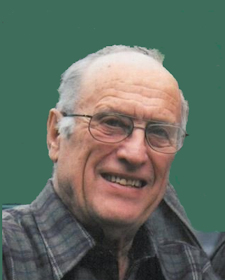
In remembrance of Wesley Ross
December 27, 1919 - † September 15, 2017

I'm grateful to Lenny Fox for letting me re-post this story.
